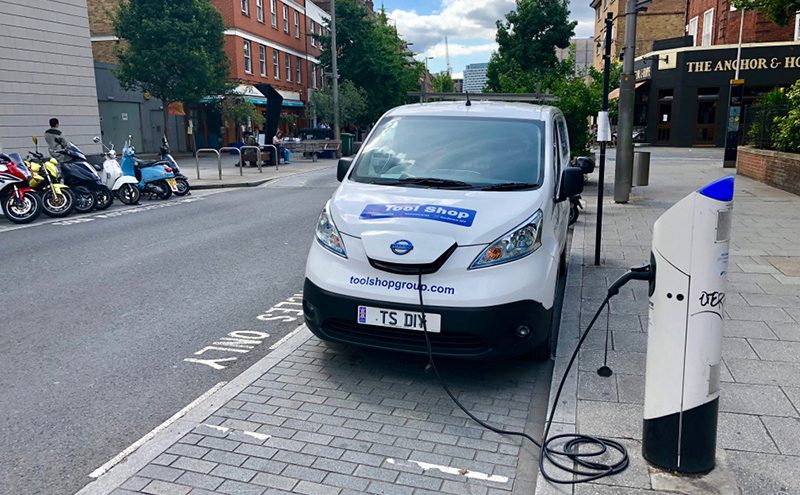
A major trial of commercial electric vehicles (EVs) has been given the green light by UK energy regulator Ofgem, bringing together leading power, technology, fleet and transport companies to test and implement the best approaches to the EV rollout for commercial enterprises.
With businesses buying 58% of all new vehicles in the UK, it will be commercial vehicles that determine the speed of the transition to low carbon transport.
This three-year innovation project will come up with practical ways of overcoming the up-front costs that are currently holding back many of the country’s biggest commercial vehicle operators from making the switch to EVs.
Led by data technology solutions provider Hitachi Vantara and electricity distributor UK Power Networks, the trial will see up to 3,000 electric vehicles from Centrica, Uber and a large UK depot-based parcel carrier take to the road, supported by distributor Scottish and Southern Electricity Networks, Hitachi Europe and Hitachi Capital Vehicle Solutions.
Infrastructure appraisal
The project will deliver an end-to-end overview of what the switch to EVs means for the cables and substations that deliver electricity to the community, for the businesses that need to invest in new infrastructure, and for the end users that need to power their vehicles. It is intentionally vehicle agnostic and includes depot, home, and on-the-road charging scenarios.
Using large, real-life datasets and Internet of Things technologies, the project will create a detailed picture of the demands of electric fleet and private hire vehicles. This will make it possible to develop solutions that cut the cost of owning and running electric vehicles, such as charging EVs outside the electricity network’s peak times.
Preparing the grid
Electric vehicle technology has now reached a maturity where the vehicles themselves are ready for day-to-day and long-distance commercial use. However, moving the energy source for transport from combustion engines is not something the electricity grid was designed for, whether charging happens in concentrated locations — such as depots — or is widespread at employees’ homes or in public places.
The UK’s big commercial vehicle operators must overcome several obstacles before they adopt electric vehicles on a large scale – all the way from the up-front capital hurdle to managing charging times.
Network operators, meanwhile, need to get a better understanding of the impact of commercial EVs on the country’s electricity grid. They are also looking to understand whether these vehicles can support the electricity network and help keep costs low for customers by discharging during peak times and recharging off-peak.
Carbon reduction urgency
The project is also vital if the UK wants to meet its carbon reduction targets. The accelerated adoption of commercial EVs will save 2.7m tonnes of CO2, equivalent to London’s entire bus fleet running for four years[1] or a full Boeing 747-400 travelling around the world 1,484 times[2]. The flexibility provided by the project will also free up enough capacity on the electricity network to supply a million homes[3].
Electric cars and vans must increase from 1.7% of new car sales today to 60% by 2030[4]. Around 3,000 electric vehicles will take to the roads in Greater London as part of project Optimise Prime to gather vital information that will help the UK to prepare for and speed up the transition to a greener and more efficient future.
The project will launch early 2019. Following a programme design and build phase, the first Optimise Prime vehicles will be on the road during the second half of 2019. The test area will include a range of urban, suburban and rural scenarios across the South East, South Central and East of England.
To help the wider industry prepare, the largest cross-industry datasets on commercial EV charging and use will be shared openly.
£18 million will be funded through partner contributions, and an additional £16.6 million will come from Ofgem via its Network Innovation Competition. Ofgem’s funding will deliver total savings of more than £200 million – equivalent to 12 times the funded amount – in benefits to UK electricity customers.
Notes
[1] The TfL bus fleet in London emits 650,000 tCO2 each year. Source: Cutting Carbon from the London Bus Fleet presentation by Finn Coyle, Environmental Manager (Transport Emissions) for TfL: https://tinyurl.com/y7whshug
[2] Based on Earth circumference at equator and 101g of CO2 produced per passenger per km flown: http://www.carbonindependent.org/sources_aviation.html
[3] Based on projections that the project could release 1.9GVA of capacity by 2030
[4] Table 5.2; Reducing UK Emissions, Committee for Climate Change https://tinyurl.com/y74w9sbo






